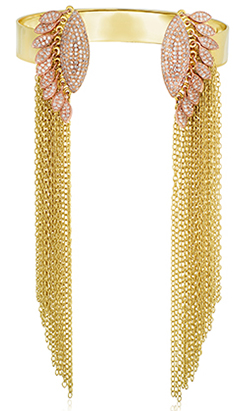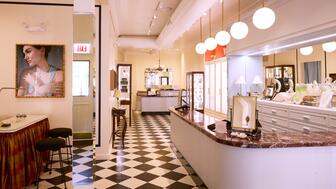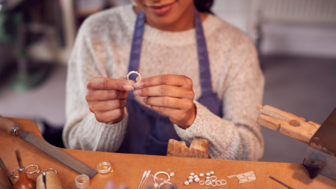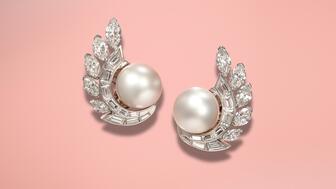The History Behind … 1970s Style
With the big, bold yellow gold jewelry of the ‘70s making a comeback, National Jeweler takes a look back at the social and cultural forces that originally shaped this decade of design.
This fall, the fashion runways in New York were full of fringe, suede and flares plus plenty of autumnal colors, and jewelry is following suit.

Yellow gold is back in a big way--illustrated by both large, gold links and more delicate pieces with fringe--turquoise can been seen in a lot of pieces and there’s a definite penchant for layering, even if the price of gold today has dramatically reduced the size of chains and pendants for most people.
Patricia Faber, who co-owns New York City’s Aaron Faber Gallery with her husband, took the time to tell us about one very fun era in fashion.
What shaped the aesthetic of jewelry in the 1970s?
“I think it was driven by counterculture,” Faber said, meaning: Woodstock, LSD, rock music and people protesting against the war and pushing for civil rights.
“Counterculture people, the rock stars, were not buying high fashion, but high fashion started to look like what they were wearing. They were influencing [it].”
Yes, there was still bridal jewelry and traditional fine jewelry being made, but in the early 1970s there was also the mainstream acceptance of the youth movement, the hippie subculture, that began in isolated pockets in the mid-1960s.
For example, Chanel came out with a long, flowy printed dress that looked like what hippies wore to the beach or to outdoor concerts like Woodstock.
As the decade wore on, clothing became more tailored but there were still bold color combinations, flared pants and loud prints (perhaps due in part to the LSD); think Pucci and the patterns on Diane Von Furstenberg’s then-new creation, the wrap dress.
Jewelry had to be bold to stand out against all the styles of this era, resulting in thick yellow gold chains worn in layers, brightly colored gemstones like turquoise and long beaded necklaces.
What else was popular during this era?
Faber said the 1970s was also a time when jewelry artists were creating really large pieces.
“Nobody,” she said, “was afraid to be bold.”
David Webb and his outstanding animal cuffs were popular alongside well-known brands like Boucheron and Bulgari.
There were also the big rings of London-based designer Andrew Grima, Cartier’s Aldo Cipullo creating chunky necklaces set with stones like jade and carnelian alongside the smaller gold pieces he’s so well known for, and Vivianna Torun making giant pieces under the Georg Jensen brand.
Donning big, bold jewels--including extremely oversized pieces of body jewelry--was a way of expressing oneself and experimenting with body decoration, much in the way that tattoos are used today.
“In jewelry, there were a lot of really wild pieces that were designed and made” in the 1970s, Faber said.
What gemstones and metals were popular?
People wanted big, bold gemstones to stand out against their flowy outfits and loud prints, and that’s what they got.
Turquoise was widely used, as were malachite and lapis lazuli, with Faber noting, “When you are working in a large scale, something that is less expensive is desirable.”
As for metals, the decade was all about yellow gold, as the metal enjoyed continued popularity from the ‘60s. Faber said the warm hue fit in with the autumnal colors, the oranges and the browns, that dominated interior design in that era.
The popularity of gold in that era also had a more practical aspect: It was relatively inexpensive in the early years of the decade.
Before 1971, when President Richard Nixon took the United States off the gold standard, the price of gold was fixed at $35 an ounce. In today’s terms, this would be the equivalent of gold costing about $220 an ounce.
On average, the gold price stayed below $100 an ounce until about 1974, before it began rising in earnest toward the end of the decade, topping $600 an ounce on average by 1980, historical data from Kitco.com shows.
“So much of jewelry style comes from, can you get it? And, do you have the technology to work with it?” Faber observed.
Should retailers dive into the ‘70s resurgence and/or add some 1970s-era estate pieces to their inventory?
Faber said it depends on the retailer and their customer because, like the Retro Modern (1940s) period, the design is very bold. It isn’t for everyone.
For those retailers who feel a connection to the era--and have a customer who would too--Faber suggested they buy a few 1970s estate pieces to mix in with the modern ‘70s-inspired looks.
This way, they can showcase the old alongside the new and have a story to tell customers: Here is an actual piece from the era contrasted with a modern designer’s take on that look today.
“It wasn’t necessarily an easy time,” Faber said of the 1970s. “But … it was a really fun period.”
The Latest

Interior designer Athena Calderone looked to decor from the 1920s and 1930s when crafting her first fine jewelry collection.

During a call about its full-year results, CEO Efraim Grinberg discussed how the company is approaching the uncertainty surrounding tariffs.

The free program provides educational content for jewelry salespeople and enthusiasts to learn or refresh their diamond knowledge.

The feedback will be used to prepare other jewelers for the challenges ahead, the organization said.


The online sessions are designed to teach jewelers to use AI tools like ChatGPT and Claude to grow their business.

The opening marks the jewelry retailer’s first location in the Midwest.

Bench jewelers spend years honing their skills, Jewelers of America’s Certification validates their talents.

The “United in Love” collection offers tangible mementos of hearts entwined with traditional and non-traditional commitment heirlooms.

Robert Goodman Jewelers will hold a “Black Jewelry Designers and Makers” event on April 27.

The announcements follow a tumultuous start to 2025 for WJA, which saw a wave of resignations following controversial statements about DEI.

Editor-in-Chief Michelle Graff answers questions about how the new taxes levied on countries like India and China will impact the industry.

Kenewendo, Botswana’s minster of minerals and energy, discusses closing the deal with De Beers and the work that was missed along the way.

The historic fancy vivid blue diamond set to headline Christie’s Geneva sale next month could sell for up to $50 million.

LVMH CFO Cécile Cabanis also discussed the effects of tariffs so far.

The “Mad Men” and “The Morning Show” star steals jewelry, art, and handbags from his wealthy neighbors in “Your Friends & Neighbors.”

The organization has reelected Kalpesh Jhaveri as president.

An investigation found that the former managing director of Movado’s Dubai branch overstated and prematurely recorded sales.

The collection pays tribute to the Japanese philosophy of Ma, studying balance, stillness, and the interplay between presence and absence.

Mari Lou’s Fine Jewelry in Orland Park, a suburb of Chicago, is closing its doors.

GIA’s labs in Dubai and Hong Kong are now accepting larger diamonds in light of the “logistical challenges” presented by the new tariffs.

These earrings by Van Cleef & Arpels, featuring the same design as a pair worn by Princess Grace, are up for auction at Woolley & Wallis.

Two experts share how artificial intelligence tools can help retailers run a more efficient business.

Kentaro Nishimura, who has been with the pearl company since 1997, has been promoted to president and CEO of Mikimoto America.

“America Telling Time: 150 Years of Bulova” explores the storied history of the American watchmaker.

An across-the-board tariff of 10 percent remains in place for all U.S. trading partners, except China.

Brigette Pheloung and Tania Sarin, and their mothers, star in the campaign wearing medallions they co-designed.


























